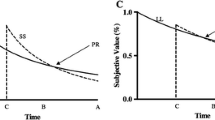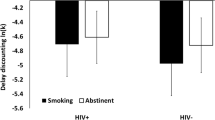Abstract
Rationale
When offered a choice between a small monetary reward available immediately (SmallNow) versus a larger reward available after a delay (LargeLater), smokers select the SmallNow alternative more than nonsmokers. That is, smokers discount the value of the LargeLater reward more than nonsmokers.
Objectives
To investigate whether this group difference was due to smokers overweighting the value of rewards available immediately compared with nonsmokers, we examined whether the group difference was also seen when both alternatives were delayed, i.e., when choosing between a SmallSoon reward and a LargeLater reward.
Methods
In Experiment 1, smokers and nonsmokers completed a task including SmallNow versus LargeLater choices and SmallSoon versus LargeLater choices. In Experiment 2, smokers and nonsmokers completed the same task but with hypothetical choices.
Results
Analyses using hyperbolic and double exponential (β–δ) models replicate prior findings that smokers discount the LargeLater reward more than nonsmokers when the smaller reward is available immediately. The smoker–nonsmoker difference was also seen when the smaller reward was slightly delayed, though this effect was primarily driven by heightened discounting in male smokers. However, for potentially real rewards only, this smoker–nonsmoker difference was significantly reduced when the smaller reward was delayed.
Conclusions
The smoker–nonsmoker difference in discounting is not confined to situations involving immediate rewards. Differences associated with potentially real versus hypothetical rewards and gender underscore the complexity of the smoking–delay discounting relationship.






Similar content being viewed by others
References
American Psychiatric Association (2000) Diagnostic and statistical manual of mental disorder, revised 4th edn. Author, Washington, D.C
American Psychological Association (2002) Ethical principles of psychologists and code of conduct. Author, Washington, D.C
Baker F, Johnson MW, Bickel WK (2003) Delay discounting in current and never-before cigarette smokers: Similarities and differences across commodity, sign, and magnitude. J Abnorm Psychol 112:382–392
Bickel WK, Odum AL, Madden GJ (1999) Impulsivity and cigarette smoking: Delay discounting in current, never, and ex-smokers. Psychopharmacology 146:447–454
Bickel WK, Pitcock JA, Yi R, Angtuaco EJ (2009) Congruence of BOLD response across intertemporal choice conditions: Fictive and real money gains and losses. J Neurosci 29:8839–8846
Bickel WK, Yi R, Mueller ET, Jones BA, Christensen DR (2010) The behavioral economics of drug dependence: Towards the consilience of economics and behavioral neuroscience. Curr Top Behav Neurosci 3:319–341
Bickel WK, Yi R, Landes RD, Hill PF, Baxter C (2011) Remember the future: Working memory training decreases delay discounting among stimulant addicts. Biol Psychiatry 69:260–265
Chaudhri N, Caggiula AR, Donny EC, Booth S, Gharib M, Craven L et al (2006) Operant responding for conditioned and unconditioned reinforcers in rats is differentially enhanced by the primary reinforcing and reinforcement-enhancing effects of nicotine. Psychopharmacology 189:27–36
Cloninger CR (1987) A systematic method for clinical description and classification of personality variants. A proposal. Arch Gen Psychiatry 44:573–588
Dallery J, Raiff BR (2007) Delay discounting predicts cigarette smoking in a laboratory model of abstinence reinforcement. Psychopharmacology 190:485–496
Derogatis LR (1994) SCL-90-R: administration, scoring, and procedures manual, 3rd edn. National Computer Systems Inc., Minneapolis, MN
Dinn WM, Aycicegi A, Harris CL (2004) Cigarette smoking in a student sample: Neurocognitive and clinical correlates. Addict Behav 29:107–126
Donny EC, Chaudhri N, Caggiula AR, Evans-Martin FF, Booth S, Gharib MA et al (2003) Operant responding for a visual reinforcer in rats is enhanced by noncontingent nicotine: Implications for nicotine self-administration and reinforcement. Psychopharmacology 169:68–76
Epstein LH, Richards JB, Saad FG, Paluch RA, Roemmich JN, Lerman C (2003) Comparison between two measures of delay discounting in smokers. Exp Clin Psychopharmacol 11:131–138
Field M, Santarcangelo M, Sumnall H, Goudie A, Cole J (2006) Delay discounting and the behavioural economics of cigarette purchases in smokers: The effects of nicotine deprivation. Psychopharmacology (Berl) 186:255–263
Figner B, Knoch D, Johnson EJ, Krosch AR, Lisanby SH, Fehr E et al (2010) Lateral prefrontal cortex and self-control in intertemporal choice. Nat Neurosci 13:538–539
Green L, Myerson J, Macaux EW (2005) Temporal discounting when the choice is between two delayed rewards. J Exp Psychol Learn Mem Cogn 31:1121–1133
Heatherton TF, Kozlowski LT, Frecker RC, Fagerström KO (1991) The Fagerström Test for Nicotine Dependence: A revision of the Fagerström Tolerance Questionnaire. Br J Addict 86:1119–1127
Heyman GM, Gibb S (2006) Delay discounting in college cigarette chippers. Behav Pharmacol 17:660–679
Johnson MW, Bickel WK (2002) Within-subject comparison of real and hypothetical money rewards in delay discounting. J Exp Anal Behav 77:129–146
Johnson MW, Bickel WK (2008) An algorithm for identifying nonsystematic data in delay discounting research. Exp Clin Psychopharmacol 16:264–274
Johnson MW, Bickel WK, Baker F (2007) Moderate drug use and delay discounting: A comparison of heavy, light, and never smokers. Exp Clin Psychopharmacol 15:187–194
Jones BA, Landes RD, Yi R, Bickel WK (2009) Temporal horizon: Modulation by smoking status and gender. Drug Alcohol Depend 104(Suppl 1):S87–S93
Kable JW, Glimcher PW (2010) An “as soon as possible” effect in human intertemporal decision making: Behavioral evidence and neural mechanisms. J of Neurophysiology 103:2513–2531
Kollins SH (2003) Delay discounting is associated with substance use in college students. Addict Behav 28:1167–1173
Laibson D (1997) Golden eggs and hyperbolic discounting. Q J Econ 112:443–477
Lawton-Craddock A, Nixon SJ, Tivis R (2003) Cognitive efficiency in stimulant abusers with and without alcohol dependence. Alcohol Clin Exp Res 27:457–546
Madden GJ, Begotka AM, Raiff BR, Kastern LL (2003) Delay discounting of real and hypothetical rewards. Exp Clin Psychopharmacol 11:139–145
Madden GJ, Raiff BR, Lagorio CH, Begotka AM, Mueller AM, Hehli DJ et al (2004) Delay discounting of potentially real and hypothetical rewards: II. Between- and within-subject comparisons. Exp Clin Psychopharmacol 12:251–261
Mazur JE (1987) An adjusting procedure for studying delayed reinforcement. In: Commons ML, Mazur JE, Nevin JA, Rachlin H (eds) The effect of delay and of intervening event on reinforcement value. Quantitative analyses of behavior, vol 5. Lawrence Erlbaum Associates, Hillsdale, NJ, pp 55–73
McClure EB, Ericson KM, Laibson DI, Loewenstein G, Cohen JD (2007) Time discounting for primary rewards. J Neurosci 27:5796–5804
McClure SM, Laibson DI, Loewenstein G, Cohen JD (2004) Separate neural systems value immediate and delayed monetary rewards. Science 306:503–507
Mitchell SH (1999) Measures of impulsivity in cigarette smokers and non-smokers. Psychopharmacology 146:455–464
Mitchell SH (2003) Discounting the value of commodities according to different types of cost. In: Heather N, Vuchinich RE (eds) Choice, behavioral economics and addiction: Theory, evidence and applications. Elsevier, New York, pp 339–357
Mitchell SH (2004) Effects of short-term nicotine deprivation on decision-making: Delay, uncertainty and effort discounting. Nicotine Tob Res 6:819–828
Mooney ME, Odlaug BL, Kim SW, Grant JE (2011) Cigarette smoking status in pathological gamblers: Association with impulsivity and cognitive flexibility. Drug Alcohol Depend 117:74–77
Nesic J, Rusted J, Duka T, Jackson A (2011) Degree of dependence influences the effect of smoking on cognitive flexibility. Pharmacol Biochem Behav 98:376–384
Odum AL, Madden GJ, Bickel WK (2002) Discounting of delayed health gains and losses by current, never- and ex-smokers of cigarettes. Nicotine Tob Res 4:295–303
Ohmura Y, Takahashi T, Kitamura N (2005) Discounting delayed and probabilistic monetary gains and losses by smokers of cigarettes. Psychopharmacology 182:508–515
Patton JH, Stanford MS, Barratt ES (1995) Factor structure of the Barratt impulsiveness scale. J Clin Psychol 51:768–774
Petry NM, Kirby KN, Kranzler HR (2002) Effects of gender and family history of alcohol dependence on a behavioral task of impulsivity in healthy subjects. J Stud Alcohol 63:83–90
Reynolds B (2006) A review of delay-discounting research with humans: Relations to drug use and gambling. Behav Pharmacol 17:651–667
Reynolds B, Karraker K, Horn K, Richards JB (2003) Delay and probability discounting as related to different stages of adolescent smoking and non-smoking. Behav Proc 64:333–344
Reynolds B, Richards JB, Horn K, Karraker K (2004) Delay discounting and probability discounting as related to cigarette smoking status in adults. Behav Proc 65:35–42
Reynolds B, Patak M, Shroff P, Penfold RB, Melanko DAM (2007) Laboratory and self-report assessments of impulsive behavior in adolescent daily smokers and nonsmokers. Exp Clin Psychopharmacol 15:264–271
Scheres A, Sumiya M, Thoeny AL (2010) Studying the relation between temporal reward discounting tasks used in populations with ADHD: A factor analysis. Int J Methods Psychol 19:167–176
Selzer ML (1971) The Michigan Alcoholism Screening Test: The quest for a new diagnostic instrument. Am J Psychiatry 127:89–94
Yi R, Mitchell SH, Bickel WK (2010) Delay discounting and substance abuse. In: Madden GJ, Bickel WK (eds) Impulsivity: The behavioral and neurological science of discounting. American Psychological Association, Washington, DC, pp 191–212
Yoon JH, Higgins ST, Heil SH, Sugarbaker RJ, Thomas CS, Badger GJ (2007) Delay discounting predicts postpartum relapse to cigarette smoking among pregnant women. Exp Clin Psychopharmacol 15:176–186
Zachary RA (1991) Shipley institute of living scale: Revised manual. Western Psychological Services, Los Angeles
Zhang H, Kranzler HR, Poling J, Gelernter J (2010) Variation in the nicotinic acetylcholine receptor gene cluster CHRNA5–CHRNA3–CHRNB4 and its interaction with recent tobacco use influence cognitive flexibility. Neuropsychopharmacology 35:2211–2224
Zuckerman M, Eysenck SBG, Eysenck HJ (1978) Sensation seeking in England and America: Cross-cultural, age and sex comparisons. J Consult Clin Psychol 46:139–149
Acknowledgements
This research was supported by R01 DA015543 (SHM) and R03 DA024195 (SHM). The authors report no conflicts of interest and did not receive funds from a commercial sponsor. The authors would like to thank Dr. Sam McClure for providing the MatLab script used to derive the β and δ values for the double exponential model, Dr. Rick Bevins for helpful discussion about the effects of nicotine and Stacy Legg for assistance conducting the experimental visits. SHM was primarily responsible for study design, and shared responsibility for data interpretation and manuscript writing with VBW. VBW conducted the experimental procedures and performed the data analyses.
Author information
Authors and Affiliations
Corresponding author
Appendix 1 Instructions received by participants
Appendix 1 Instructions received by participants
Experiment 1
This task has 210 questions. For each question, you can choose between two options by clicking on it using the computer mouse. You can change your selection as often as you like and there is no right or wrong answer — we are interested in your personal preferences. Once you have finally decided which option you prefer you can register your preference and go on to the next question by clicking on the “next question” box.
You will make choices between two amounts of money. One or both of the amounts of money will be available after a delay.
Remember, at the end of the task, one of the questions that you answered will be chosen at random. You should answer all of the questions on the task honestly, because you will actually receive whatever you chose on that question. If you chose “money now” you will receive that amount of money at the end of the task and if you chose “money later” you will actually have to wait before receiving the money.
Please try the demonstration below. When you are ready to begin the task, click on the “begin task” box.
Experiment 2
This task has 210 questions. For each question, you can choose between two options by clicking on it using the computer mouse. You can change your selection as often as you like and there is no right or wrong answer — we are interested in your personal preferences. Once you have finally decided which option you prefer, you can register your preference and go on to the next question by clicking on the “next question” box.
You will make choices between two amounts of money. One or both of the amounts of money will be available after a delay. Imagine that the choices you are making are real — that if you choose “money now” you would receive that amount of money at the end of the task and that if you choose “money later” that you would actually have to wait before receiving the money.
Please try the demonstration below. When you are ready to begin the task, click on the “begin task” box.
Rights and permissions
About this article
Cite this article
Mitchell, S.H., Wilson, V.B. Differences in delay discounting between smokers and nonsmokers remain when both rewards are delayed. Psychopharmacology 219, 549–562 (2012). https://doi.org/10.1007/s00213-011-2521-z
Received:
Accepted:
Published:
Issue Date:
DOI: https://doi.org/10.1007/s00213-011-2521-z




